
The San Clemente Island goat is a type of domestic goat derived from feral goats isolated on San Clemente Island, one of the Channel Islands of California.

The San Clemente Island goat is a type of domestic goat derived from feral goats isolated on San Clemente Island, one of the Channel Islands of California.
The long-isolated feral goats of the Channel Islands, including the San Clemente Island goat and the Santa Catalina Island goat are thought to be descendants of goats brought to the islands by Spanish missionaries and settlers; breeds such as la Blanca Celtiboras, la Castellana Extremenas, and later the more common dairy and meat goats of Spain, the Malaguenas and Murciana goats. [1] They first arrived on San Clemente from Santa Catalina Island, in 1875, and there they remained feral until the United States Navy, which was under a directive to preserve the endangered flora and fauna of the island that were threatened by the grazing of nonendemic species, [2] sought their removal. After initial trapping and hunting failed to eliminate the goats, the Navy began a shooting program to exterminate them. This was blocked in court by the Fund for Animals, [3] which asserted the goats did not hurt any endangered species, and thought the Navy was using this claim as an excuse. This was incorrect, as the threatened and endangered species of plants were already federally listed and protected by the Endangered Species Act. [4]
Goats were put up for adoption on the mainland by the Clapp family and by the Fund for Animals. [3] The U.S. Navy was given the right to exterminate the remaining goats, and the last goat on San Clemente Island was killed in April, 1991. [5]
San Clemente Island goats are small, fine-boned, and deer-like. The males sport outwardly twisting, "Spanish-type" horns. Both sexes are horned and although their large horns resemble those of Spanish goats, San Clemente goats are not of Spanish origin. The Livestock Conservancy (formerly ALBC) with the University of Cordoba in Spain conducted a DNA study of the breed in 2007 and found that the San Clemente goat is a genetically distinct breed and unrelated to the numerous other breeds in the study. San Clemente Island goats are listed as a critically endangered heritage breed on the Conservation Priority List by the Livestock Conservancy. In 2020, their global population was about 1400. They live on the mainland U.S.A. and in Canada. [6]

The Texas Longhorn is an American breed of beef cattle, characterized by its long horns, which can span more than 8 ft (2.4 m) from tip to tip. It derives from cattle brought from the Iberian Peninsula to the Americas by Spanish conquistadores from the time of the Second Voyage of Christopher Columbus until about 1512. For hundreds of years the cattle lived a semi-feral existence on the rangelands; they have a higher tolerance of heat and drought than most European breeds.

The Channel Islands are an eight-island archipelago located within the Southern California Bight in the Pacific Ocean, off the coast of California. The four Northern Channel Islands are part of the Transverse Ranges geologic province, and the four Southern Channel Islands are part of the Peninsular Ranges province. Five of the islands are within the Channel Islands National Park, and the waters surrounding these islands make up Channel Islands National Marine Sanctuary. The Nature Conservancy was instrumental in establishing the Channel Islands National Marine Sanctuary. The islands were inhabited as early as 13,000 years ago, the earliest paleontological evidence of humans in North America. They are the easternmost islands in the Pacific Island group.

The island fox is a small fox that is endemic to six of the eight Channel Islands of California. There are six subspecies, each unique to the island it lives on, reflecting its evolutionary history. They are generally docile, show little fear of humans, and are easily tamed. Island foxes played an important role in the spiritual lives of native Channel Islanders. They have been likely semi-domesticated as pets, used as pelts, or for other functions, like pest control.
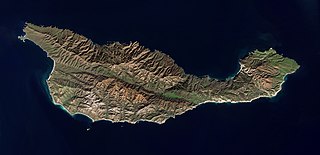
Santa Cruz Island is located off the southwestern coast of Ventura, California, United States. It is the largest island in California and largest of the eight islands in the Channel Islands archipelago and Channel Islands National Park. Forming part of the northern group of the Channel Islands, Santa Cruz is 22 miles (35 km) long and 2 to 6 miles wide with an area of 61,764.6 acres (249.952 km2).
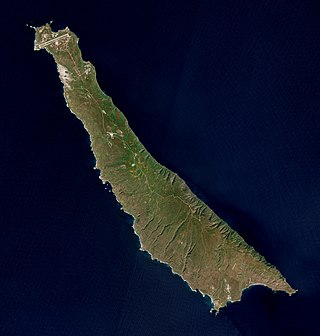
San Clemente Island is the southernmost of the Channel Islands of California. It is owned and operated by the United States Navy, and is a part of Los Angeles County. It is administered by Naval Base Coronado. It is 21 miles (34 km) long and has 147.13 km2 (56.81 sq mi) of land. The 2018 census estimates 148 military and civilian personnel reside on the island. The city of San Clemente in Orange County, California is named after the island.

Quercus tomentella, the island oak, island live oak, or Channel Island oak, is an oak in the section Protobalanus. It is native to six islands: five of the Channel Islands of California and Guadalupe Island, part of Baja California.

Colonial Spanish horse is a term for a group of horse breed and feral populations descended from the original Iberian horse stock brought from Spain to the Americas. The ancestral type from which these horses descend was a product of the horse populations that blended between the Iberian horse and the North African Barb. The term encompasses many strains or breeds now found primarily in North America. The status of the Colonial Spanish horse is considered threatened overall with seven individual strains specifically identified. The horses are registered by several entities.

The Catalina Island Conservancy is a nonprofit organization established to protect and restore Santa Catalina Island, California, United States. The Conservancy was established in 1972 through the efforts of the Wrigley and Offield families. The Conservancy was created when both families deeded 42,135 acres (170.51 km2) of the island over to the organization—88% of the Island.

The Livestock Conservancy, formerly known as the American Livestock Breeds Conservancy (ALBC) and prior to that, the American Minor Breeds Conservancy, is a nonprofit organization focused on preserving and promoting rare breeds, also known as "heritage breeds" of livestock. Founded in 1977, through the efforts of livestock breed enthusiasts concerned about the disappearance of many of the US's heritage livestock breeds, the Conservancy was the pioneer livestock preservation organization in the United States, and remains a leading organization in that field. It has initiated programs that have saved multiple breeds from extinction, and works closely with similar organizations in other countries, including Rare Breeds Canada. With 3,000 members, a staff of nine and a 19-member board of directors, the organization has an operating budget of almost half a million dollars.

Hog Island sheep are a breed of sheep descended from animals first brought to Virginia's Hog Island in the 18th century. During the 1930s and 1940s, storm conditions forced the island's residents to evacuate, leaving some sheep behind. These sheep adapted to the environment free of human intervention, becoming feral.
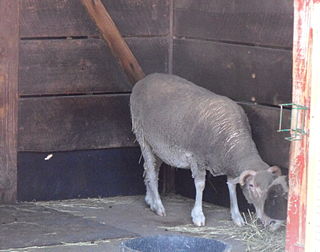
Santa Cruz sheep are an extremely rare breed of domestic sheep that once existed as a feral population on the Santa Cruz Island of the Channel Islands of California. Small and hardy, the sheep were all killed or removed from the island to prevent destruction of natural habitats. Today, they number fewer than 200 animals. This breed is primarily raised for wool.

The feral goat is the domestic goat when it has become established in the wild. Feral goats occur in many parts of the world.

Santa Catalina Island is a rocky island off the coast of Southern California in the Gulf of Santa Catalina. The island name is often shortened to Catalina Island or just Catalina. The island is 22 mi (35 km) long and 8 mi (13 km) across at its greatest width. The island is located about 29 mi (47 km) south-southwest of Long Beach, California. The highest point on the island is Mount Orizaba. Geologically, Santa Catalina is part of the Channel Islands of California archipelago and is the easternmost of the Channel Islands. Politically, Catalina Island is part of Los Angeles County in District 4. Most of the land on the island is unincorporated.
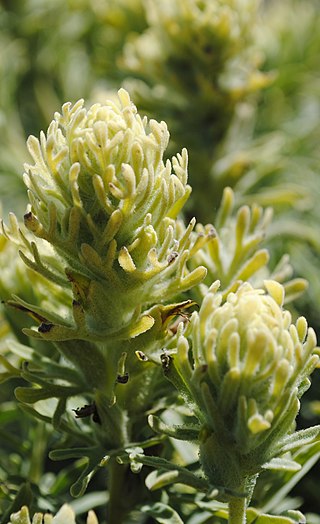
Castilleja grisea is a rare species of Indian paintbrush known by the common name San Clemente Island Indian paintbrush. It is endemic to San Clemente Island, one of the Channel Islands of California. San Clemente Island is owned by the US Navy so the Navy is involved in a management program to recover this species.
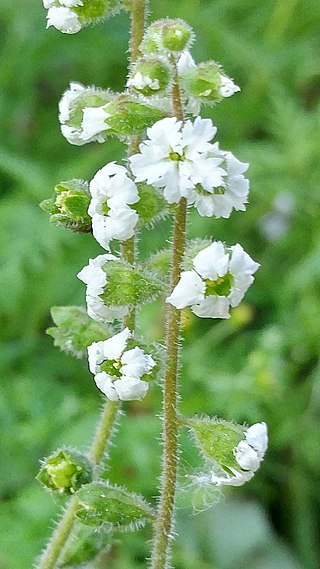
Lithophragma maximum, known by the common name San Clemente Island woodland star, is a rare species of flowering plant in the saxifrage family. It is endemic to San Clemente Island, one of the eight Channel Islands of California. It is known from only about four kilometers of rocky coastal cliffs on the edge of the island. The plant was thought to be extinct until a few specimens were rediscovered in 1979. Only 200 individuals were tallied in a 1996 survey. In 1997 the plant was listed as an endangered species on the federal level.
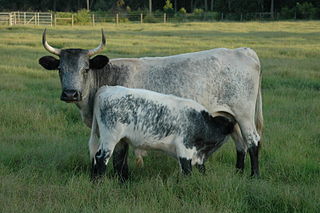
The Florida Cracker or Florida Scrub is an American breed of cattle which originated in Spanish Florida and later in the American state of Florida. It is named for the Florida cracker culture in which it was kept. It is one of the Criollo breeds that descend from the Spanish cattle originally brought to the Americas by the Spanish Conquistadors; among the other North American breeds in this group are the Pineywoods, the Corriente and Texas Longhorn. Unlike the Pineywoods – to which it is closely related – the Florida Cracker has not been inter-bred with breeds of North European origin.

The Ossabaw Island Hog or Ossabaw Island is a breed of pig derived from a population of feral pigs on Ossabaw Island, Georgia, United States. The original Ossabaw hogs are descended from swine released on the island in the 16th century by Spanish explorers. A breeding population has been established on American farms off the island, but they remain a critically endangered variety of pig.
Murciana, also called Murcian, Murcien, Murciene and Royal Murciana is a dual-purpose breed of goat originally bred in the Murcia province along the Mediterranean coast of southeastern Spain. The main milk-producing goat breed in Spain is a cross between the Murciana and the Granadina goat known as Murciano-granadina goat. Only the latter is officially recognized by the Spanish government, so Murciana goats are considered a variety of such breed.

The San Clemente loggerhead shrike or San Clemente Island loggerhead shrike is a subspecies of the loggerhead shrike that is endemic to San Clemente Island, California.
The wildlife of the Channel Islands of California is wide and diverse, including many endemic species. While the land wildlife is slightly limited, there being only one large, naturally predatory, and native mammal, the small island fox, marine life can include anything from kelp forests to great white sharks.